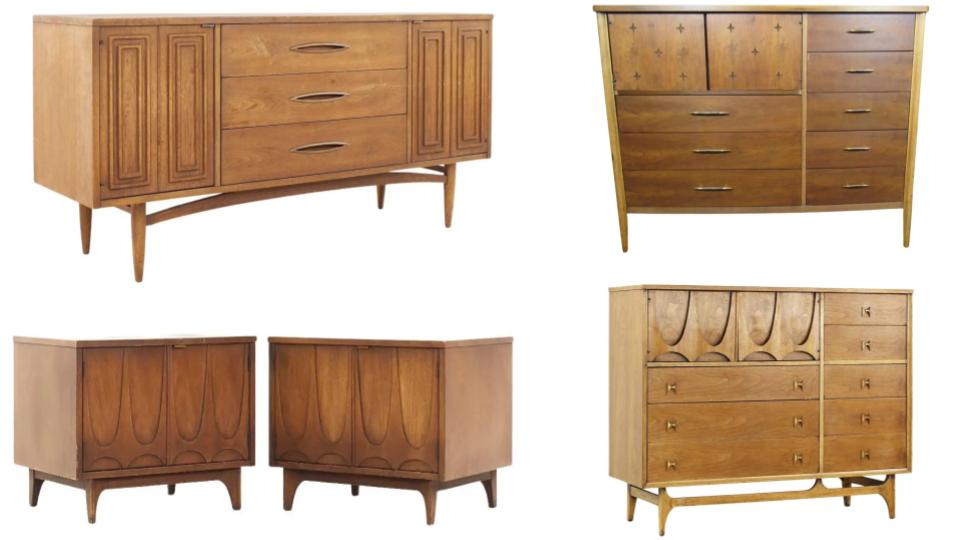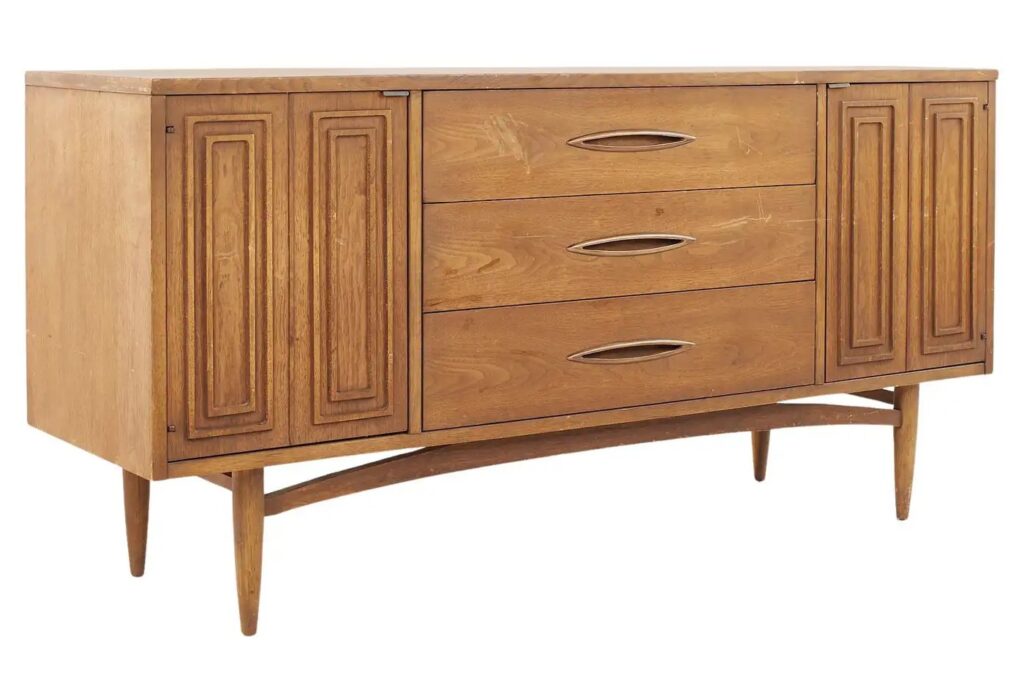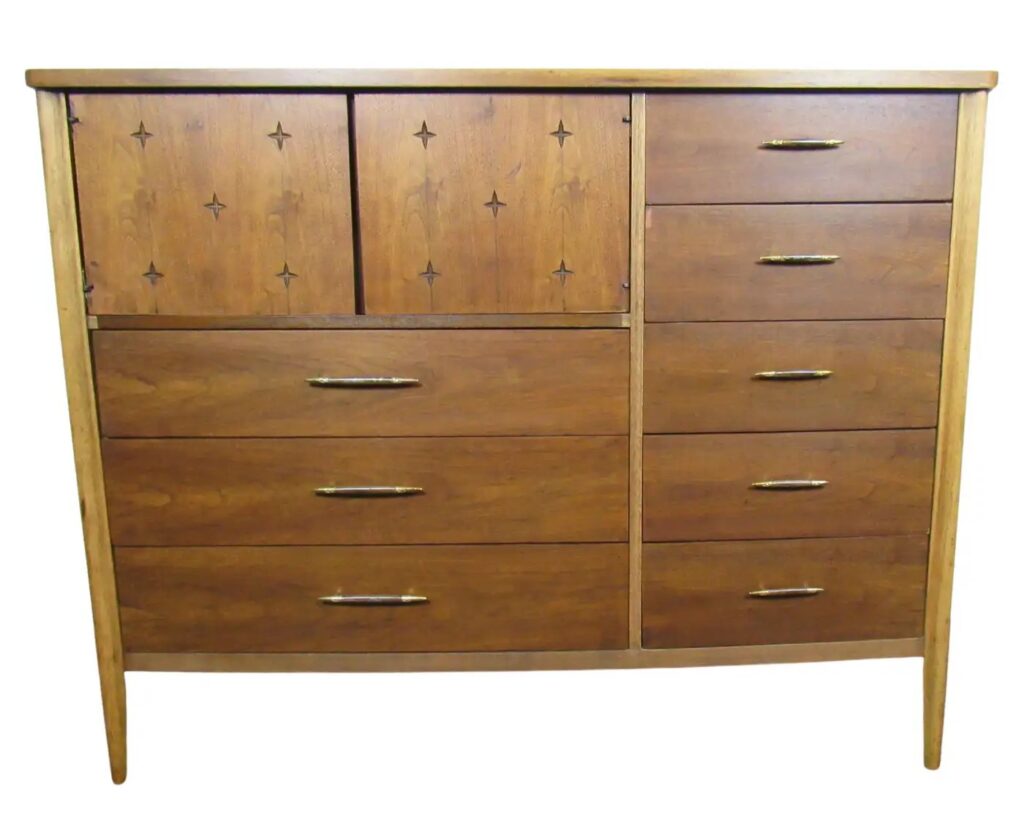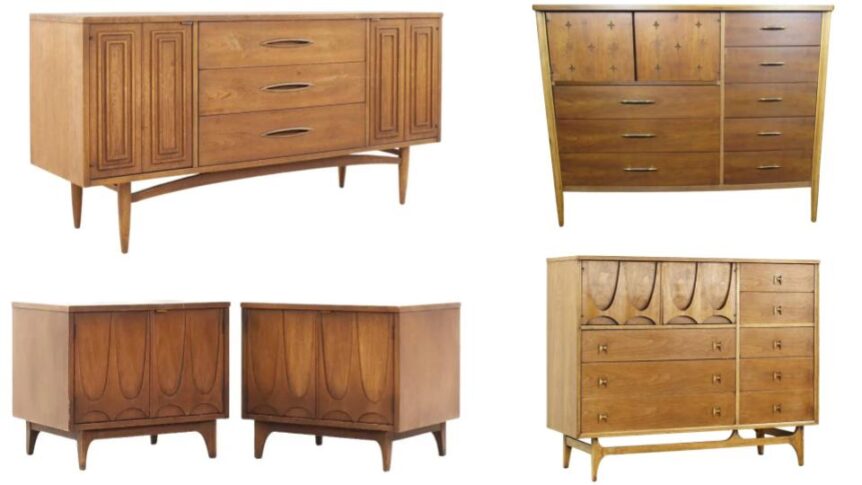Brasilica, Saga, and Sculptra: The Inside Scoop on Broyhill’s Classic Mid-Century Collections

Vintage Broyhill furniture from the mid-20th century is highly coveted among collectors and interior designers alike. With their high-quality craftsmanship and iconic mid-century modern aesthetic, Broyhill pieces from the 1950s–1970s have skyrocketed in popularity and value in recent years.
In this comprehensive guide, we’ll explore the history of the Broyhill Furniture company, provide tips on identifying and valuing their vintage collections like Sculptra, Saga, and Brasilia, and outline the key design elements that make Broyhill’s mid-century pieces so special. Read on for a deep dive into the origins, history, and charm of vintage Broyhill.
Overview of Broyhill Furniture Company
The Broyhill Furniture company has a long and storied history that spans over a century. Founded in 1926 in, North Carolina by Thomas H. Broyhill, the company started out as a small operation called Broyhill Family Furnishings.
Within just a few decades, Broyhill experienced rapid growth and expansion. By the late 1920s, the company had established itself as the largest furniture manufacturer in the state of North Carolina.
In its early years, Broyhill Furniture focused on producing high quality bedroom suites, formal dining sets, and occasional furniture. Many of their earliest furniture lines had a very traditional and formal Colonial American style. Mahogany and walnut were commonly used. Design motifs included canopy beds, sleigh beds, highboys, breakfront china cabinets, and pedestal dining tables.
During the 1920s and 1930s, Broyhill furniture evolved to reflect popular Art Deco and Art Moderne styles. Case goods from this era featured glossy lacquered finishes in black and white paired with exotic burled wood veneers. Chrome hardware also became a signature accent in Broyhill’s Deco-inspired furnishings. The company proved it could adapt with the times and styles.
The most significant shift occurred after World War II when Broyhill began producing furniture in the newly fashionable mid-century modern aesthetic. Abandoning their traditional roots, Broyhill’s mid-century lines emphasized simplicity, minimalism, and functionality for contemporary open floor plans. This transition truly defined the company for decades to come. Iconic collections like Premier, Brasilia, Saga, and Sculptra introduced in the 1950s and 1960s cemented Broyhill as a leader in mid-century trends.
Broyhill’s Sculptra Furniture

The Broyhill Sculptra collection debuted in the 1960s and exemplified the company’s focus on high-quality materials and craftsmanship during this era. The Sculptra line featured furniture with smooth, rounded edges and a slanted, asymmetrical appearance.
Sculptra pieces were constructed from premium walnut solids and veneers. They had a hand-rubbed finish that showcased the natural grain of the wood. Hardware was made from solid brass for durability. The hand-rubbed finish brought out the depth and visual interest of the natural walnut grain patterns. And the solid brass pulls and knobs used for handles and drawer pulls gave the Sculptra pieces a touch of mid-century flair.
Some identifying features of Sculptra furniture include:
- Slanted, asymmetrical shapes
- Rounded edges
- Walnut solids and veneers
- Brass hardware
- Hand-rubbed finish
The Sculptra collection included both case goods like credenzas and sideboards as well as occasional items like end tables. Some popular examples include:
- Sculptra Lowboy Credenza: This lower credenza featured angled sides and brass hardware. The hand-rubbed walnut finish highlighted the rich wood grain.
- Sculptra China Cabinet: Also known as a breakfront cabinet, the Sculptra version had a slanted shape almost like an accordion. The wood veneers were carefully matched to create a continuous walnut grain pattern across the doors.
- Sculptra Oval Cocktail Table: Mimicking the oval shape seen in many Sculptra case goods, this oval coffee table had bent wood sides and distinctively angled tapered legs.
Broyhill produced the Sculptra line until the early 1970s. Today, these vintage mid-century pieces are highly sought after by collectors. Prices can range from $800 for small occasional tables up to $4,000 or more for larger case goods in good condition. The clean lines and asymmetry of Sculptra furniture give it an unmistakably retro-modern appeal.
Related articles:
- Stag Furniture Ranges – A Look at the Best of British Mid-Century Design
- 20 Best Mid-Century Modern Furniture Brands
- Drexel Heritage Furniture: A Guide to One of the Vintage Icons
- How to Identify Vintage Ethan Allen Furniture
Broyhill’s Saga Furniture

The Saga collection by Broyhill debuted in the late 1950s and was produced into the 1970s. Saga featured clean lines and subtle detailing inspired by Danish modern design.
Constructed from quality hardwood solids and veneers like walnut and rosewood, Saga furniture had a warm, natural appearance that epitomized mid-century style. Hardware was made from solid metal for durability. The mix of rich wood grains combined with sleek metal pulls and tapered legs created the minimalist aesthetic Saga was known for.
Some key identifying traits of Saga include:
- Clean, minimalist lines
- Warm hardwood solids and veneers
- Subtle details like tapered legs
- Durable metal hardware
- Inspired by Danish modern design
The collection included dining sets, case goods, upholstered chairs, and occasional tables. Some of the most popular Saga items include:
- Saga Double Pedestal Dining Table: Made from beautiful teak or walnut veneers, the Saga dining table had simple parsons design with square tapered legs. Extensions allowed it to expand for entertaining.
- Saga Sideboard: The minimalist sideboard featured wood cabinet doors with recessed rectangular handles. It had a warm walnut grain and sat atop slim tapered legs.
- Saga China Cabinet: Often paired with the matching sideboard, the Saga breakfront china cabinet had a simple unadorned design. Its most identifiable feature was the beautiful wood grain visible through the glass doors.
- Saga Lounge Chairs: Available with leather or fabric upholstery, the lounge chairs had deep comfortable seats and a low profile perfect for conversation areas.
- Saga Oval Coffee Table: A classic mid-century shape, the oval table had tapered legs like many designs in the Saga line. Its teak veneer top showcased the wood’s natural richness.
Vintage Saga furniture from the 1960s and 1970s can sell for $800-$5,000 or more depending on the size and condition. As an iconic Broyhill mid-century line, Saga furnishings are highly coveted among collectors today.
Related articles:
- Top 1980s Furniture Brands: Vintage Classics from Kartell to Herman Miller
- 10 Best Vintage Danish Furniture Brands of the 1960s and 1970s
- How To Identify Vintage Henredon Furniture
Broyhill Brasilia Furniture

Brasilia was another popular Broyhill collection from the 1960s and early 70s. Drawing inspiration from South American design, Brasilia mixed materials like woven cane, leather, and wood for visual interest.
Broyhill Brasilia furnishings had a tropical, nature-inspired look. They often incorporated woven cane or leather along with warm-toned wood solids and veneers. Examples include dining chairs with woven cane backs and upholstered leather seats, as well as credenzas and cabinets with caned doors. The juxtaposition of the smooth leather against the textural woven cane gave Brasilia furniture great visual depth and appeal.
Other details of note include:
- Mixed natural materials like wood, cane, leather
- Warm wood tones (walnut, mahogany, teak)
- Tapered legs
- Subtle brass hardware
Some of the most sought-after pieces from the Brasilia line include:
- Brasilia Dining Table and Chairs: The set featured a handsome teak dining table paired with chairs that had sturdy wooden frames, woven cane backs, and leather seat cushions.
- Brasilia China Cabinet: Designed to complement the dining set, the breakfront cabinet had caned wood doors and sides contrasted by a sleek solid wood top.
- Brasilia Desks and Credenzas: Brasilia home office furniture had the same mixed materials scheme with caned cabinet fronts and drawers accented with leather desk blotters.
- Brasilia Coffee and Side Tables: Occasional tables like the oval cocktail table combined solid teak wood tops with lower shelves enclosed in woven caned frames.
This tropically inspired collection has an exotic, modern look that epitomizes Broyhill’s mid-century style. Vintage Brasilia regularly commands prices upwards of $1,000-$5,000 depending on the size and condition.
Key Design Elements of Vintage Broyhill Furniture
While Broyhill produced many iconic lines, there are some overarching traits that make their vintage mid-century pieces so special. Here are some of the key design elements to look for:
- High-quality woods: Broyhill furniture from the 1950-70s was constructed from premium hardwood solids and veneers like walnut, rosewood, and teak. This lends a warm, natural look and feel. Figured grain veneers were carefully selected and matched to create stunning wood patterns.
- Clean lines and angles: Mid-century modern style emphasized simplicity and minimalism. Broyhill designs have straight lines and angular shapes. Cases goods often had an asymmetrical, almost cubist look.
- Tapered legs: Brasilica credenzas feature tapered legs while Saga end tables often have splayed legs, both stylistic mid-century details. The tapered legs were often made from quality solid woods like walnut rather than plastic or metal.
- Expert craftsmanship: Dovetail joinery, wood inlay, brass hardware, and hand-rubbed finishes demonstrate quality construction. Broyhill employed master woodworkers to hand-finish each piece ensuring consistency and durability.
- Danish inspiration: Scandinavian design and modern Danish shapes influenced popular lines like Saga and Premier. This gave Broyhill furniture a light, contemporary appeal.
- Comfortable proportions: Dimensions and angles were designed for comfort and utility. Tables and seating have human-centered proportions. Chairs feature ergonomic shapes with padded seats and backrests.
These thoughtful details and high-end materials set Broyhill furniture apart from other brands and make their vintage pieces so covetable today. With proper care, they stand the test of time in both quality and aesthetics.
Related articles:
Valuing Vintage Broyhill Furniture
For both collectors and interior design enthusiasts, vintage Broyhill offers high-end mid-century style. Here are some tips for finding and valuing authentic pieces:
- Check manufacturer stamps and labels for the Broyhill name and collection details. This helps confirm it is a genuine vintage piece. Originally, most Broyhill furniture had a manufacturer’s label attached somewhere on the underside or back.
- Study wood grains, joinery, hardware, and other construction details that indicate quality materials and handcraftsmanship. The attention to wood selection and matching of grains on cabinets and case goods is a mark of Broyhill’s quality and craftsmanship during their vintage era.
- Consult design guides to identify and learn values for different collections like Sculptra, Saga, and Brasilica. There are online collector’s guides that provide average price ranges for vintage Broyhill based on the line and condition. These can serve as a pricing reference.
- Vintage Broyhill prices often start around $800-$2,000 for occasional furniture up to $3,000-$6,000 or more for larger case pieces. Excellent condition increases value. Original condition with no repairs or damage can potentially double valuations.
- Shop vintage dealers, auction sites, and classified ads for authentic mid-century Broyhill finds. Pieces with original finish and no damage will be most valuable. Credenzas, china cabinets, dining sets and lounge chairs turn up frequently at auctions and vintage shops.
With an understanding of Broyhill history and designs, you can discover amazing vintage pieces to add warmth, charm, and value to any space.
Here are some additional tips for spotting quality vintage Broyhill furniture when shopping secondhand:
- Inspect furniture for signs of high-quality construction like dovetail joints, consistent finishes, and secure cabinet doors and drawers. Look inside cabinets and drawers for Broyhill stickers and date stamps.
- Check legs and bases for manufacturer stamps like the engraved Premier mark found on many authentic mid-century Broyhill chairs and tables.
- Look for intact original hardware like wooden drawer pulls and metal tapered legs. Replacement hardware brings down the value.
- Watch for damage like scratched finishes, water rings, missing pieces, or repairs like glue marks. Some wear is expected but major damage devalues vintage furniture.
- Feel wood surfaces for smooth hand-rubbed finishes. Finishes should not feel thick or tacky if original.
- Evaluate fabric and upholstery condition on vintage chairs and sofas. Stains, tears, or threadbare areas lower desirability.
- Assess joints between wood pieces – they should fit flush without gaps or uneven edges if the item was properly manufactured.
FAQ About Vintage Broyhill Furniture
Why is Broyhill Brasilia so expensive?
There are several factors that make Brasilia furniture by Broyhill so valuable and expensive for vintage collectors today:
- High-Quality Materials – Brasilia pieces were crafted from premium exotic woods like rosewood, teak and macassar ebony from Brazil, hence the name. These materials were costly at the time.
- Association with Jens Risom – The Brasilia collection was designed by renowned Danish mid-century designer Jens Risom and carries his stylistic influence. Risom’s name adds to the allure.
- Limited Production Run – Brasilia was only produced for a short window in the early 1960s, making authentic pieces rare. Less supply drives up prices.
- Iconic Mid-Century Style – The mix of materials and sleek profiles epitomized mid-century chic. This vintage appeal causes prices to continuously rise.
- Handcrafted Construction – Dovetail joints and hand-rubbed finishes demonstrate the quality craftsmanship that collectors covet.
- High Demand – As more people decorate with mid-century aesthetics, demand for Brasilia has skyrocketed beyond existing supply. Scarcity further increases values.
What kind of wood is Broyhill Brasilia?
Authentic Brasilia furniture by Broyhill was meticulously crafted from exotic hardwoods native to Brazil that were considered luxury materials at the time. Typical woods used include:
- Rosewood – Prized for its dark coloration and pronounced grain patterns. Used for case goods and tables.
- Macassar Ebony – A rare ebony wood with distinctive stripes and swirls in the grain. Seen on credenzas and cabinets.
- Teak – Known for its natural oil content, warm honey color and straight grain. Used for chair and table frames.
- Palisander – A reddish-brown wood related to Brazilian rosewood. Featured on cabinets and sideboards.
- Santos Rosewood – Has a mix of tan and purple hues that created a unique visual effect. Used as accents and inlays.
The rich tones and natural beauty of these woods helped give Brasilia furniture it’s exotic, nature-inspired aesthetic that was the hallmark of this iconic Broyhill mid-century collection.
Conclusion
Vintage Broyhill furniture represents the height of mid-century modern style and quality craftsmanship. Iconic lines like Sculptra, Saga, and Brasilia combine high-end materials, clean aesthetics, and thoughtful design. With proper care and restoration, authentic Broyhill pieces from the 1950s-1970s make stunning and valuable additions to any space.
This guide provides an overview of Broyhill’s history, tips for identifying and valuing popular vintage collections, and advice for incorporating these timeless designs into your home. From Brasilica’s tropical flair to Saga’s Danish inspiration, Broyhill’s innovative furnishings transformed mid-century interior design and continue to be coveted by collectors today.
Whether you are looking to add some vintage appeal to your dining room with an iconic Saga set, display heirloom china in a handsome Basilia cabinet, or relax in a Sculptra swivel chair, Broyhill’s mid-century designs are built to enrich interiors for generations to come. By understanding subtle details like tapered legs, signature hardware, and expert craftsmanship, you can seek out quality vintage Broyhill furniture


